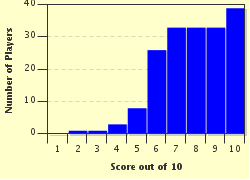Quiz Answer Key and Fun Facts
1. What is the proper term for a baby turkey?
2. Which of the following statements about turkeys is true?
3. What is the proper term for a group of wild turkeys?
4. A turkey's gender can be ascertained by its droppings.
5. Which of the following is the proper term for a male turkey?
6. The wild turkey is indigenous to which continent?
7. The wild turkey was hunted nearly to extinction by the early 1900s.
8. What skill does a wild turkey have that domestic turkeys lack?
9. What is the name of the fleshy protuberance that is found on the forehead of a male turkey?
10. A male turkey has which of the following attributes which it uses when competing for females?
Source: Author
dcpddc478
This quiz was reviewed by FunTrivia editor
guitargoddess before going online.
Any errors found in FunTrivia content are routinely corrected through our feedback system.

